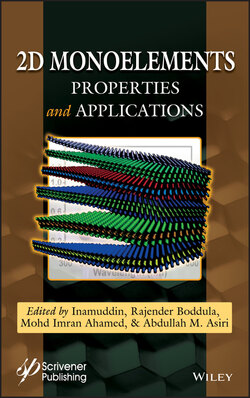Читать книгу 2D Monoelements - Группа авторов - Страница 56
2.5 Conclusion and Outlook
ОглавлениеAntimonene, a newly discovered 2D materials, has remarkable optical, electronic, optoelectronic, physical, and chemical properties, including environmental stability, wideband saturable adsorption, tunable band gap, high carrier mobility, generous active sites, superior photothermal performance, and biocompatibility, which enable it to have potential applications in many fields. In traditional 2D materials, changes in the number of layers usually affect only the size of band gap. What makes 2D antimonene unique is its strong spin-orbit coupling and the semi-metallic nature of its bulk form, allowing for adjustable electronic behaviors by varying the layer numbers. These significant features drive researchers to prepare antimonene to better understand its properties and develop its practical applications. Like other 2D materials, mechanical exfoliation was the first method to peel off high-quality mono- or few-layer antimonene at ambient conditions, and then LPE was used to realize the scalable production of antimonene. The epitaxial growth technique was further explored to deposit large-area few- or even single-layer antimonene on different substrates. Other methods were also developed to prepare antimonene with various morphs, such as solution-phase synthesis, plasma-assisted growth, and CVD. Future research can focus on achieving more effective exfoliation, since the successful preparation of antimonene was the premise of verifying the theoretically predictive properties and exploring its practical applications.
Recent works have unveiled some appealing properties of antimonene in experiments and further demonstrated its practical applications. Few-layer antimonene showed broadband nonlinear optical response and high photothermal efficiency (48%), allowing for the applications in lasers, optical switchers, optical modulators, and optical thresholders, which were important in the next-generation optical communication. With a tunable band gap (0–2.28 eV) and high carrier mobility, antimonene was employed as an effective photoactive material in the PVSCs and organic photovoltaics. Generous active sites and large surface area in antimonene made it a suitable catalyst in the catalytic process of CO2RR, HER, and OER. On the basis of high theoretical capacity (660 mAh g−1) along with fast ion diffusion, few-layer antimonene was considered to be an excellent electrode material in SIBs, LIBs, and supercapacitors. As an effective photothermal and contrast agent, antimonene can be used in the PTT, PDT, and PAI for high-performance cancer theranostics. Based on the current status of research on the properties and applications of antimonene, it is expected to enhance the performance by functionalization or modification and then develop its potential applications in more other fields.
To summarize, it is particularly important to predict the properties of antimonene more accurately in theory. Moreover, effective methods are needed to exfoliate or synthesize 2D antimonene, and then, high performance and diverse applications are expected to be realized in future.
